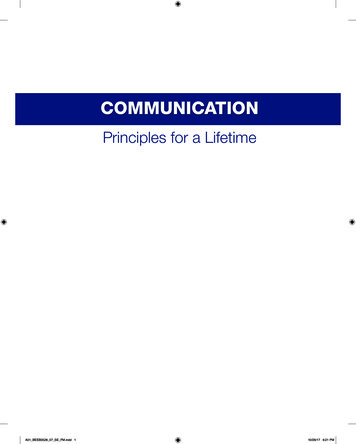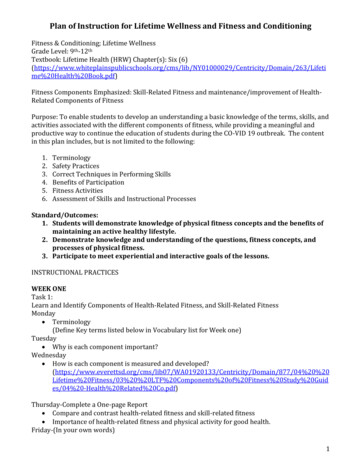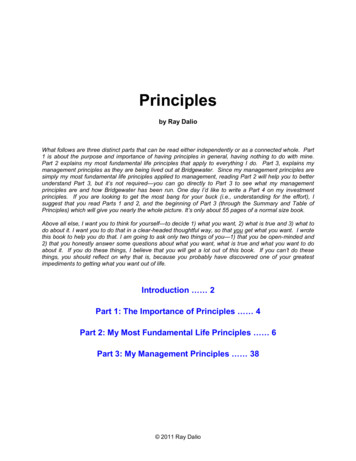
Transcription
COMMUNICATIONPrinciples for a LifetimeA01 BEEB3528 07 SE FM.indd 110/26/17 6:21 PM
A01 BEEB3528 07 SE FM.indd 210/26/17 6:21 PM
COMMUNICATIONPrinciples for a LifetimeSeventh EditionSteven A. BeebeTexas State UniversitySusan J. BeebeTexas State UniversityDiana K. IvyTexas A&M University–Corpus ChristiA01 BEEB3528 07 SE FM.indd 310/26/17 6:21 PM
Director, Portfolio Management: Karon BowersContent Producer: Barbara CappuccioContent Developer: Ellen KeohanePortfolio Manager Assistant: Dea BarbieriProduct Marketer: Christopher BrownField Marketer: Kelly RossContent Producer Manager: Melissa FeimerManaging Editor: Maggie BarbieriContent Development Manager: Sharon GearyContent Developer, Learning Tools: Amy WetzelArt/Designer: Kathryn FootDigital Studio Course Producer: Amanda SmithFull-Service Project Manager: SPi GlobalCompositor: SPi GlobalPrinter/Binder: LSC Communications, Inc.Cover Printer: Phoenix Color/HagerstownCover Designer: Lumina Datamatics, IncCover Illustration: pjjones/GettyImagesCredits and acknowledgments borrowed from other sources and reproduced, with permission, in this textbook appear on theappropriate page of appearance or in the Credits on pages 429–432.Copyright 2019, 2016, 2013 by Pearson Education, Inc. or its affiliates. All Rights Reserved. Printed in the United Statesof America. This publication is protected by copyright, and permission should be obtained from the publisher prior to any prohibited reproduction, storage in a retrieval system, or transmission in any form or by any means, electronic, mechanical,photocopying, recording, or otherwise. For information regarding permissions, request forms and the appropriate contactswithin the Pearson Education Global Rights & Permissions department, please visit www.pearsoned.com/permissions/.PEARSON, ALWAYS LEARNING, and Revel are exclusive trademarks in the U.S. and/or other countries owned by PearsonEducation, Inc. or its affiliates.Unless otherwise indicated herein, any third-party trademarks that may appear in this work are the property of their respectiveowners and any references to third-party trademarks, logos or other trade dress are for demonstrative or descriptive purposesonly. Such references are not intended to imply any sponsorship, endorsement, authorization, or promotion of Pearson’s products by the owners of such marks, or any relationship between the owner and Pearson Education, Inc. or its affiliates, authors,licensees or distributors.Library of Congress Cataloging-in-Publication DataNames: Beebe, Steven A., author. Beebe, Susan J., author. Ivy,Diana K., author.Title: Communication : principles for a lifetime / Steven A. Beebe, TexasState University, Susan J. Beebe, Texas State University, Diana K. Ivy,Texas A&M University, Corpus Christi.Description: Seventh edition. Boston : Pearson Education, [2019]Identifiers: LCCN 2017035713 ISBN 9780134553528 ISBN 0134553527Subjects: LCSH: Communication.Classification: LCC HM1206 .B44 2019 DDC 302.2—dc23 LC record available at https://lccn.loc.gov/2017035713Instructor’s Review Copy:ISBN 10:0-13-455385-3ISBN 13: 978-0-13-455385-6Access Code Card:ISBN 10:0-13-456730-7ISBN 13: 978-0-13-456730-3118à la carte Edition:ISBN 10:0-13-455381-0ISBN 13: 978-0-13-455381-8Student Rental Edition:ISBN 10:0-13-455352-7ISBN 13: 978-0-13-4553528A01 BEEB3528 07 SE FM.indd 411/8/17 3:16 PM
For our teachers and our studentsA01 BEEB3528 07 SE FM.indd 510/26/17 6:21 PM
A01 BEEB3528 07 SE FM.indd 610/26/17 6:21 PM
Brief ContentsUNIT IPRINCIPLES OF COMMUNICATION1 Identifying Foundations of Human Communication 12 Exploring Self-Awareness and Communication 273 Understanding Verbal Messages 494 Understanding Nonverbal Messages 695 Listening and Responding 916 Adapting to Others: Diversity and Communication UNIT II117INTERPERSONAL COMMUNICATION7 Understanding Interpersonal Communication 1488 Enhancing Relationships 168UNIT IIICOMMUNICATING IN GROUPS AND TEAMS9 Understanding Group and Team Performance 10 Enhancing Group and Team Performance UNIT IV193215PUBLIC SPEAKING11 Developing Your Speech 24612 Organizing and Outlining Your Speech 27413 Delivering Your Speech 29314 Speaking to Inform 31815 Speaking to Persuade 339A Interviewing 365B Sample Speeches for Discussion and Evaluation 387viiA01 BEEB3528 07 SE FM.indd 710/26/17 6:21 PM
A01 BEEB3528 07 SE FM.indd 810/26/17 6:21 PM
ContentsPreface xvUNIT I PRINCIPLES OF COMMUNICATION1 Identifying Foundations of HumanCommunication 1Why Study Communication? To Improve Your Employability To Improve Your Relationships To Improve Your Health 2344The Communication Process Communication Defined Communication Characteristics 556Communication Models Communication as Action: Message Transfer Communication as Interaction: Message Exchange Communication as Transaction: Message Creation 991011Communication Competence The Message Should Be Understood The Message Should Achieve Its Intended Effect The Message Should Be Ethical 12131313Communication & Ethics: Is There a UniversalEthical Code? 14Communication in the 21st Century Immediate Communication Frequent Communication 141515Communication & Social Media: Got Facebook?How We Connect on Facebook 16Communication That Meets Our Needs Comfortable Communication 1717Communication Contexts Interpersonal Communication Group Communication Presentational Communication Applying Communication in Organizational andHealth Contexts 18181818Communication Principles for a Lifetime Principle One: Be Aware of Your Communication withYourself and Others 19Communication & Diversity: Communication Principlesfor a Lifetime: Principles for All Cultures? Principle Two: Effectively Use and InterpretVerbal Messages 19202021Principle Three: Effectively Use and InterpretNonverbal Messages Principle Four: Listen and Respond Thoughtfullyto Others Principle Five: Appropriately Adapt Messagesto Others STUDY GUIDE: Review, Apply, and Assess 22232324Review Key Terms Apply AssessThe Principle Points2 Exploring Self-Awareness andCommunication 27Self-Awareness: How Well Do You Know Yourself? 29Self-Concept: Who Are You? Self-Concept Components 3030Communication & Diversity: Self-Concept fromEast and West 31One or Many Selves? How the Self-Concept Develops 3132Self-Esteem: What’s Your Value? Gender Social Comparisons Self-Expectations 34353536Communication & Social Media: The “Selfie” 36Self-Fulfilling Prophecy 37Communication and the Enhancement of Self-Esteem Engage in Positive Self-Talk 3737Communication & Ethics: Can You Have TOOMuch Self-Esteem? 38Visualize Reframe Develop Honest Relationships Surround Yourself with Positive People Lose Your Baggage 3839393940The Perception Process Stage One: Attention and Selection Stage Two: Organization Stage Three: Interpretation When Perceptions Vary 4041414243ixA01 BEEB3528 07 SE FM.indd 910/26/17 6:22 PM
xContentsCommunicate to Enhance Your Powers of Perception Increase Your Awareness Avoid Stereotypes Check Your Perceptions 43444445STUDY GUIDE: Review, Apply, and Assess 46Review Key Terms Apply AssessCommunication & Diversity: Lessons from a Studentin a Wheelchair The Principle Points3 Understanding Verbal Messages 49Why Focus on Language? 51The Nature of Language People Use Words as Symbols People Attach Meanings to Words People Create Denotative and Connotative Meaningsfor Words People Convey Concrete and Abstract Meaningsthrough Words Meanings Are Culture Bound 525252Communication & Social Media: To Tweet or Notto Tweet: 140 Characters or Less Meanings Are Context Bound The Nature of Nonverbal Communication The Culture-Bound Nature of NonverbalCommunication The Rule-Governed Nature of NonverbalCommunication The Ambiguous Nature of Nonverbal Communication 53535454557474747575The Continuous Nature of Nonverbal Communication 76The Nonlinguistic Nature of NonverbalCommunication 76The Multichanneled Nature of NonverbalCommunication 77Codes of Nonverbal Communication Appearance Body Movement, Gestures, and Posture 777778Communication & Social Media: Fitness Posts onSocial Media: Do Comparisons Have Consequences? 78Eye Contact Facial Expressions Touch The Voice Physical Environment, Space, and Territory 7980818283The Power of Words 55Confronting Bias in Language Biased Language: Race, Ethnicity, Nationality,and Religion Biased Language: Sex, Gender, and SexualOrientation 56How to Interpret Nonverbal Cues More Accurately 8557An Application of Nonverbal Communication Research:Detecting Deception 86STUDY GUIDE: Review, Apply, and Assess 8857Communication & Diversity: Sex/Gender Complexity:Facebook’s Fifty-Six Terms for Gender Identity 59Communication & Ethics: “That’s So Gay!” 60Biased Language: Age, Class, and Ability 61Using Words to Establish Supportive Relationships 62Describe Your Own Feelings Rather ThanEvaluate Others 63Solve Problems Rather Than Control Others 63Empathize Rather Than Remain Detached from Others 64Be Flexible Rather Than Rigid Toward Others 64Present Yourself as Equal Rather Than Superior 64Avoid Gunny-Sacking 65STUDY GUIDE: Review, Apply, and Assess 66Review Key Terms Apply AssessThe Principle Points4 Understanding Nonverbal Messages 69Why Focus on Nonverbal Communication? Nonverbal Messages Communicate Feelings andAttitudes Nonverbal Messages Are More Believable ThanVerbal Ones Nonverbal Messages Are Critical to SuccessfulRelationships Communication & Ethics: Do We Have a RhythmOr Are You Just Mimicking Me? Nonverbal Messages Serve Multiple Functions A01 BEEB3528 07 SE FM.indd 10717172Review Key Terms Apply AssessThe Principle Points5 Listening and Responding 91The Importance of Listening and Responding Skills Listening Enhances Our Relationshipswith Others Listening Helps Us Collaborate with Others Listening Links Speaker and Audience 92How We Listen Selecting Attending Understanding Remembering Responding 949494949595Listening Styles Relational Listening Style Analytical Listening Style Critical Listening Style Task-Oriented Listening Style The Benefits of Understanding Your Listening Style 95959696969792939372Listening Barriers Self Barriers Information-Processing Barriers 989810073Communication & Diversity: Does Gender InfluenceListening Skill? 10173Context Barriers 10210/26/17 6:22 PM
ContentsImproving Your Listening Skills Stop: Turn Off Competing Messages Look: Listen with Your Eyes Listen: Understand Both Details and Major Ideas Improving Your Responding Skills Responding to Clarify and Confirm Understanding 103104105106108108Communication & Social Media: Keep SocialMedia Social 110Responding to Empathize with Others 111Communication & Ethics: Paraphrase Properly 112Responding to Provide Social Support 112STUDY GUIDE: Review, Apply, and Assess 115Review Key Terms Apply AssessThe Principle Points6 Adapting to Others: Diversityand Communication 117Understanding Diversity Sex and Gender Gender Identity and Sexual Orientation Age Ethnicity 119119121122124Culture and Communication 125Defining Culture xi125Communication & Diversity: Diversity Almanac 126Communication & Social Media: Adapting toDifferences When Making E-Connections 127Cultural Contexts 128Cultural Values 128Barriers to Bridging Differences and Adapting to Others Assuming Superiority Assuming Similarity Assuming Differences Stereotyping and Prejudice 133133134135136Communication & Ethics: Can Stereotyping OthersEver Be a Good Idea? 136Adapting to Others Who Are Different from You Aim for Intercultural Communication Competence Seek Information Ask Questions and Listen Tolerate Ambiguity Develop Mindfulness Become Other Oriented Ethically Adapt to Others 137137139139140140140142STUDY GUIDE: Review, Apply, and Assess 145Review Key Terms Apply AssessThe Principle PointsUNIT II INTERPERSONAL COMMUNICATION7 Understanding InterpersonalCommunication What Is Interpersonal Communication? 148149Initiating Relationships 150Interpersonal Attraction: Why We Like Whom We Like 151Communication & Diversity: Besties: Straight Womenand Gay Men Communicating Our Attraction 151154Communication & Social Media: Consider the Flirtmoji 155Initiating Relationships Maintaining Relationships Self-Disclosure: Revealing Yourself to Others Properties of Self-Disclosure Communication & Social Media: Becoming FacebookOfficial: A Current Incarnation of “Going Steady,”“Wearing a Letter Jacket,” or “Getting Pinned” Two Models of Self-Disclosure Expressing Emotions 155159159160161161163Communication & Ethics: Are You a Blurter? 163STUDY GUIDE: Review, Apply, and Assess 165Review Key Terms Apply AssessThe Principle Points8 Enhancing Relationships The Importance of Relationships: Friends, Family,and Colleagues A01 BEEB3528 07 SE FM.indd 11Friendship Matters Family Matters Communication & Social Media: The Joys (and Woes)of the Video Chat Colleagues Matter 172172Stages of Relationship Development Relational Escalation Relational De-Escalation 173174175Communication & Ethics: Cyber Infidelity:Is It Cheating If You Don’t Actually Touch? 176Relationship Dissolution (a.k.a. the Breakup) Best Practices in Breaking Up After the Breakup: Communicating with an Ex 177177179Tensions in Relationships: The Dialectical Perspective 179Managing Interpersonal Conflict Constructive Versus Destructive Conflict Types of Conflict Properties of Conflict 180180182182Communication & Diversity: Coping with Conflict acrossCultures 183Styles of Managing Conflict Conflict Management Skills STUDY GUIDE: Review, Apply, and Assess 168169171184185188Review Key Terms Apply AssessThe Principle Points16910/26/17 6:22 PM
xiiContentsUNIT III COMMUNICATING IN GROUPS AND TEAMS9 Understanding Group and TeamPerformance 193Groups and Teams Defined Communicating in Small Groups 195195Communication & Social Media: Keep Your PhoneOut of Sight 197Communicating in Teams Communication & Ethics: How Far Would You Go toAchieve a Team Goal? When Not to Collaborate in Groups and Teams 197198198Group and Team Dynamics Roles Rules Norms Status Power Cohesiveness 199199202203204204206Group and Team Development Orientation Conflict Emergence Reinforcement 207208208209209Communication & Diversity: The Impact of Individualismand Collectivism on Groups and Teams 210The Process Nature of Group Phases STUDY GUIDE: Review, Apply, and Assess What Effective Group and Team Members Do Structuring Group and Team Problem Solving Step 1: Identify and Define the Problem Step 2: Analyze the Problem Step 3: Generate Creative Solutions Step 4: Select the Best Solution 221222223224226Communication & Ethics: What If Someone Can’tStop Judging? 226Step 5: Take Action Enhancing Group and Team Leadership Trait Approach Functional Approach Styles Approach Situational Approach 228229229230231232Communication & Diversity: Deep and Surface Diversity:Which Differences Make a Difference? 223Transformational Leadership 234210235235237212Communication & Social Media: Virtual Meeting Tips 238STUDY GUIDE: Review, Apply, and Assess 241The Principle PointsPerformance 217217218218219219220Enhancing Group and Team Meetings Manage Meeting Structure Manage Meeting Interaction Review Key Terms Apply Assess10 Enhancing Group and TeamIdentify a Clear, Elevating Goal Develop a Results-Driven Structure Gather and Share Appropriate Information Develop Options Evaluate Ideas Develop Sensitivity toward Others Develop a Positive Personal Style Review Key Terms Apply AssessThe Principle Points215217UNIT IV PUBLIC SPEAKING11 Developing Your Speech 246Overviewing the Public Speaking Process 247Building Your Confidence 248Developing Your Speech Step by Step: ConsideringYour Audience 249Understand Public Speaking Anxiety Know How to Develop a Speech Be Prepared Give Yourself a Mental Pep Talk Use Deep-Breathing Techniques Focus on Your Audience Focus on Your Message Take Advantage of Opportunities to Speak Explore Additional Resources A01 BEEB3528 07 SE FM.indd 12249250250250250250251251251Selecting and Narrowing Your Topic Who Is the Audience? What Is the Occasion? What Are My Interests and Experiences? Conducting Silent Brainstorming Scanning Web Directories and Web Pages Listening and Reading for Topic Ideas 251251252252252253253Developing Your Speech Step by Step: Selecting andNarrowing Your Topic 253Identifying Your Purpose General Purpose Specific Purpose 254254255Communication & Ethics: Is It Ethical to Buya Speech? 256Developing Your Central Idea 25610/26/17 6:22 PM
ContentsDeveloping Your Speech Step by Step: IdentifyingYour Purpose An Audience-Centered Idea A Single Idea A Complete Declarative Sentence Direct, Specific Language Developing Your Speech Step by Step: DevelopingYour Central Idea 256257258258258259Generating Main Ideas Does the Central Idea Have Logical Divisions? Can You Think of Several Reasons the CentralIdea Is True? Can You Support the Central Idea with a Series ofSteps or a Chronological Sequence? 259259Gathering Supporting Material 261Developing Your Speech Step by Step: Generating YourMain Ideas 261Sources of Supporting Material Communication & Social Media: Facebook andthe 2016 U.S. Presidential Campaign Types of Supporting Material 260260261263264Developing Your Speech Step by Step: GatheringSupporting Material 267Communication & Diversity: How to Adapt to YourDiverse Audience 269Acknowledgment of Supporting Material STUDY GUIDE: Review, Apply, and Assess 269271Review Key Terms Apply AssessThe Principle Points12 Organizing and OutliningYour Speech Organizing Your Main Ideas 274275Communication & Social Media: Your Speech as a“Content Sandwich” 275Organizing Ideas Topically Organizing Ideas Chronologically Organizing Ideas Spatially Organizing Ideas to Show Cause and Effect Organizing Ideas by Problem and Solution 276276277277277Communication & Diversity: AcknowledgingCultural Differences in Organizing Messages 278Communication & Ethics: The Ethics of Primacyand Recency 279Organizing Your Supporting Material 279Signposting: Organizing Your Speech for the Earsof Others Previews Verbal and Nonverbal Transitions Summaries 280280280281Introducing and Concluding Your Speech Introductions Conclusions 281282283Outlining Your Speech Preparation Outline Speaking Notes 285285286A01 BEEB3528 07 SE FM.indd 13xiiiSample Preparation Outline 287STUDY GUIDE: Review, Apply, and Assess 290Review Key Terms Apply AssessThe Principle Points13 Delivering Your Speech 293Methods of Delivery Manuscript Speaking Memorized Speaking Impromptu Speaking Extemporaneous Speaking 294294295296296Effective Verbal Delivery Using Words Clearly Using Words Accurately Crafting Memorable Word Structures 297297298298Effective Nonverbal Delivery Eye Contact 300300Communication & Diversity: The Academic Quarter 301Physical Delivery Facial Expression Vocal Delivery Developing Your Speech Step by Step: RehearsingYour Speech Appearance 301303303305305Effective Presentation Aids Types of Presentation Aids 306306Communication & Social Media: CommunicatingSocial Media Statistics with Computer-GeneratedPresentation Aids 308Communication & Ethics: Profanity in an AudioPresentation Aid 310Additional Guidelines for Preparing and UsingPresentation Aids 310Some Final Tips for Rehearsing and DeliveringYour Speech 312Developing Your Speech Step by Step: DeliveringYour Speech 313Criteria for Evaluating Speeches 314STUDY GUIDE: Review, Apply, and Assess 315Review Key Terms Apply AssessThe Principle Points14 Speaking to Inform 318Types of Informative Speeches Speeches about Objects Speeches about Procedures Speeches about People 319319320320Communication & Ethics: Confidential orPotentially Dangerous Information 321Speeches about Events Speeches about Ideas Strategies for Organizing Your Informative Speech Organizing Speeches about Objects Organizing Speeches about Procedures Organizing Speeches about People 32132232232232332310/26/17 6:22 PM
xivContentsOrganizing Speeches about Events Organizing Speeches about Ideas 324324Strategies for Making Your Informative Speech Clear 325Communication & Diversity: Using an Interpreter 325Simplify Ideas Pace Your Information Flow Relate New Information to Old 325326326The Unreceptive Audience 355Sample Persuasive Speech: "Private Ambulances," byBlake Bergeron 356STUDY GUIDE: Review, Apply, and Assess 359Review Key Terms Apply AssessThe Principle PointsA Interviewing 363Strategies for Making Your Informative SpeechInteresting Relate to Your Listeners’ Interests Use Attention-Getting Supporting Material Establish a Motive for Your Audience to Listen to You Use Word Pictures 326326327327328Communication & Social Media: “Killer” Presentationson Social Media Types of Interviews Information-Gathering Interview Appraisal Interview Problem-Solving Interview Persuasion Interview Job Interview 364364365365365365329Phases of an Interview The Opening The Body: Asking Questions The Conclusion 366366367369How to Be Interviewed for a Job Be Aware of Your Skills and Abilities Prepare Your Résumé 370370370Sample Résumé 373Create Interesting Presentation Aids Use Humor Strategies for Making Your Informative SpeechMemorable Build in Redundancy Use Adult Learning Principles Reinforce Key Ideas Verbally Reinforce Key Ideas Nonverbally 329329330331331331332Sample Informative Speech: "Elvis," by Angelitta Armijo 333STUDY GUIDE: Review, Apply, and Assess 335Review Key Terms Apply AssessCommunication & Social Media: Putting YourBest Facebook Image Forward The Principle Points15 Speaking to Persuade 337Understanding Persuasion Persuasion Defined The Psychology of Persuasion 338338338Communication & Ethics: Hidden Agendas 339Developing Your Audience-Centered Persuasive Speech Narrowing Your Topic Identifying Your Purpose Developing Your Central Idea as a PersuasiveProposition 342342342Supporting Your Persuasive Message with Credibility,Logic, and Emotion Ethos: Establishing Your Credibility Logos: Using Evidence and Reasoning Communication & Diversity: “Elementary Reasoning,My Dear Watson” Pathos: Using Emotion 342344344346347348Organizing Your Persuasive Message Problem–Solution Cause and Effect Refutation The Motivated Sequence 349349350351351Communication & Social Media: The MotivatedSequence in Advertising 353Adapting Ideas to People and People to Ideas The Receptive Audience The Neutral Audience 353354354A01 BEEB3528 07 SE FM.indd 14Identify the Needs of Your Potential Employer Look and Communicate Your Best Polish Your Online Appearance Listen, Respond, and Ask Appropriate Questions Follow Up after the Interview 374374375376376378How to Be Interviewed in an Information-GatheringInterview Prepare for the Interview Listen Effectively Respond Appropriately 378378379379The Responsibilities of the Interviewer Be Aware of Biases and Prejudices Adapt to an Interviewee’s Behavior Deal Wisely with Sensitive Content Listen Effectively Record Information Ask Appropriate Questions 379380380380380380380STUDY GUIDE: Review, Apply, and Assess 382Review Key Terms Apply AssessThe Principle PointsB Sample Speeches for Discussionand Evaluation 385Informative Speech: “Audism,” by Cimmi Alvarez 385Persuasive Speech: “Doctors and Sex Abuse,” byCole Hanzlicek 387Notes Credits Index 39142943310/26/17 6:22 PM
PrefaceCommunication is essential for life. The purpose of this book is to documentthis claim by presenting fundamental principles of human communicationthat enhance the quality of our communication with others as well as thequality of our own lives. Most students who read this book will take only one coursein communication during their entire college career. We want students to view thiscourse on communication as a vital, life-enriching one that will help them enhancetheir communication with others—not just as another course in a string of curricularrequirements. Because communication is an essential element of living, we want students to remember essential communication principles and skills for the rest of theirlives. To remember and apply these essential communication principles, we believestudents need a digest of classic and contemporary research and practice that will helpthem with both the mundane and the magnificent, the everyday and the ever-importantcommunication experiences that constitute the fabric of their lives.In this edition, as in the six that preceded it, we strive to create a highly appealing,easy-to-use text that is more effective than ever in helping students understand and usethe five vital principles of communication.Revel Revel is an interactive learning environment that deeply engages students and preparesthem for class. Media and assessment integrated directly within the authors’ narrativelets students read, explore interactive content, and practice in one continuous learning path. Thanks to the dynamic reading experience in Revel, students come to class prepared to discuss, apply, and learn from instructors and from each other.Learn more about Revelwww.pearson.com/revelSpecial Features for Communication StudentsRevel is a dynamic learning experience that offers students a way to study the contentand topics relevant to communication in a whole new way. Rather than simply offeringopportunities to read about and study public speaking, Revel facilitates deep, engaginginteractions with the concepts that matter most. For example, as they are introduced tothe concept of communication competence in Chapter 1, students are prompted to complete a self-assessment of their own self-perceived communication competence. Alsoin Chapter 1, students are first presented with our pentagon model, which illustratesthe relationships among the five communication principles that are the overarchingstructure of the book. In Revel, students can interact with this figure to learn more aboutxvA01 BEEB3528 07 SE FM.indd 1510/26/17 6:22 PM
xviPrefacethese five principles. By providing opportunities to readabout and practice communication concepts and techniquesin tandem, Revel engages students directly and immediately,which leads to a better understanding of course material.A wealth of student and instructor resources and interactivematerials can be found within Revel. Some of our favoritesinclude: Audio Excerpts and Speech AnnotationsStudents can listen to audio recordings of interpersonal conversations, typical and useful phrases for group discussions,and public speech excerpts while they read. These audioclips bring examples and communication tips to life. Videos and Video Self-ChecksStudents are presented with video examples throughout thebook on topics such as ethical communication, diversity andunderstanding, perception and self, active listening, listeningbarriers, effective group roles, and leadership styles, amongother topics. Many videos have correlating self-checks,enabling students to test their knowledge. Interactive FiguresInteractive figures show processes in action and provide active visualizations formost of the figures in the text. Integrated Writing OpportunitiesTo help students connect chapter content with personal meaning, each chapteroffers two varieties of writing prompts: Journal prompts elicit free-form, topicspecific responses (one per module) and an end-of-chapter Shared Writing promptencourages students to share and reply to each other’s brief responses to highinterest topics.For more information about all of the tools and resources in Revel and access toyour own Revel account for the Communication: Principles for a Lifetime, Seventh Edition,go to www.pearson.com/revel.A01 BEEB3528 07 SE FM.indd 1610/26/17 6:22 PM
PrefacexviiWhat’s New to the SeventhEdition?Reviewers, instructors, and our students have given us feedback aboutthe six previous editions. This feedback has helped us make this newedition the best possible teaching and learning resource. We listenedand responded (Principle Four) to their suggestions. Our commitmentto providing a digest of essentials that does not overwhelm studentshas also led us to make some changes. One immediate change you’llsee in this edition is a fresh new design with many new photos to helpdraw today’s visually oriented learners into the text.We have also included the following new features in everychapter: New Communication & Social Media features explore ways to effectively usesocial media as an important communication tool. The chapter-end Study Guide has been significantly revised and reorganized forthis edition. Learning objectives, review summaries, key terms, and apply andassess questions are now organized by section. These features have been designedto help students master chapter content, prepare for exams, and apply chapterconcepts to their own lives. Significantly updated and expanded research incorporates the latest research findings about the principles and skills of human communication. Fresh, contemporary examples and illustrations are ones to which students canrelate. New photos and illustrations amplify the content of our message.We’ve also updated popular continuing features that appearthroughout the book, including the following: Revised learning objectives appear at the beginning of each chapterto provide students with advance organizers and reading goals forapproaching the chapter. Revised Communication & Diversity features complement andexpand discussions of new applications of research about diversitythroughout the book. Revised Communication & Ethics features reinforce the importance of being anethical communicator and may spark discussion of ethical questions.A01 BEEB
Principles for a Lifetime Seventh Edition Steven A. Beebe Texas State University Susan J. Beebe Texas State University Diana K. Ivy Texas A&M University–Cor










